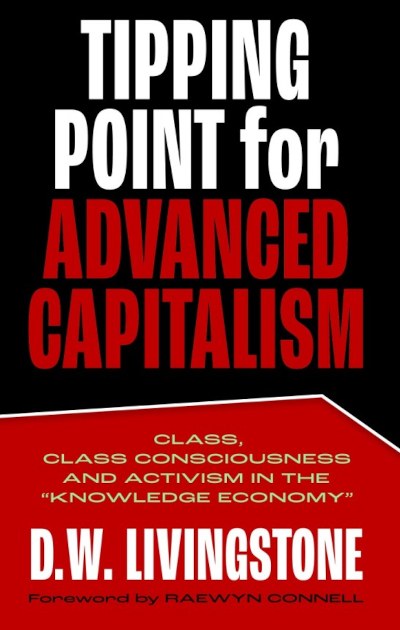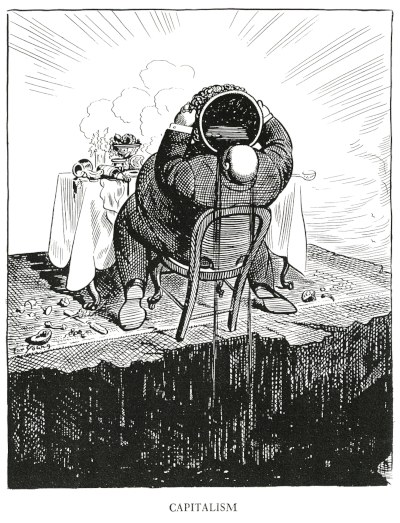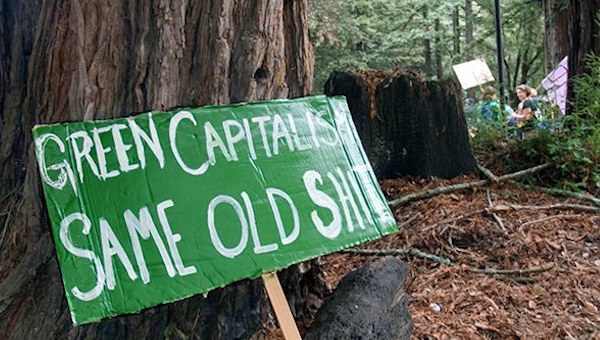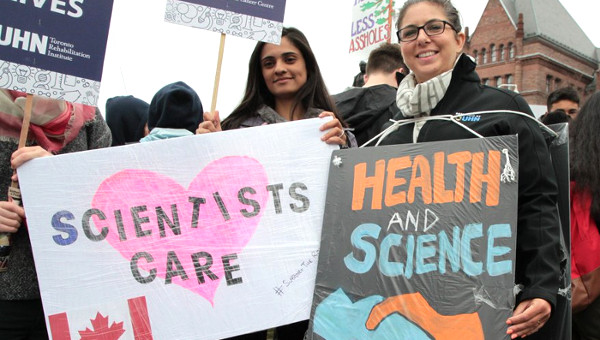Class Leaders and Tipping Point for Advanced Capitalism
We are living in the most dangerous time for the human species since our early origins. The massive numbers of wildfires destroying large swaths of Canada and elsewhere this summer are one sign among many that we are mere years away from irreversible environmental degradation. The Ukraine War reminds us that we are within a few minutes of nuclear winter. We are witnessing historic highs in the inequitable concentration of wealth and lows in popular confidence in elected governments. The capitalist system is driven by the obsessive need to turn every conceivable material good and service into profitable commodities regardless of longer-term sustainability of life. Even as we become concerned about more evident environmental threats to decent life, many pragmatically accept current commodity comforts while ignoring their connection with the corporate profit drive. Since the neoliberal offensive in the 1980s and weakening of the labour movement, there is rarely much scrutiny of class relations between owners, managers and workers, to say nothing of their different roles in producing the tipping point between capitalist oblivion and sustainable alternatives.

The basic aim of Tipping Point for Advanced Capitalism: Class, Class Consciousness and Activism in the “Knowledge Economy” is to bring class back into thinking about capitalism and alternatives. My colleagues and I have been conducting rare series of surveys of the Canadian labour force and of corporate executives since the 1980s documenting basic patterns and changes in class structure and political consciousness. Early chapters document continuity and change in the tripartite class structure of owners, managers and non-managerial employees in G7 and Nordic countries. Please note that renewing systematic analysis of class exploitation does not mean denying the importance of gender and racial oppression – and their interactions (Seccombe and Livingstone 1999). But later chapters of Tipping Point focus on the depth of corporate elites’ obsession with excessive profits, and also show the much greater numbers of class-conscious workers fighting for economic democracy and livable futures. The book makes a plea for more comparable studies to fully understand these class relations in advanced capitalism and elsewhere and provides tools to do so.
Strategic Class Agents
Direct empirical evidence on strategic class leaders involved in setting goals, determining goal-related actions and mobilizing resources to achieve goals is extremely rare – for the very good reason that class protagonists are typically loathe either to expose real motives or to admit their strategies in this dangerous struggle. But given the existential challenge of the imminent tipping point between capitalist oblivion and sustainable alternatives, much greater efforts should be made to understand strategic class forces centrally involved in either defending or transforming advanced capitalism. This excerpt summarizes the studies in Tipping Point addressing this question.
Class Leaders, Class Consciousness and Public Policy
In the prior chapter I documented the different levels of opposed class consciousness in advanced capitalist countries. At one extreme, there is hegemonic capitalist consciousness. This includes identifying yourself in a dominant class position, supporting profit maximization and opposing the right to strike, as well as adhering to a profit-driven societal vision and managerial prerogative. Conversely, revolutionary labour consciousness includes identifying yourself in a subordinate class position, opposing profit maximization and supporting the right to strike, as well as promoting a non-profit economy based on worker self-management. The absolute numbers have been relatively small. But I also showed in all advanced capitalist countries for which there is direct evidence that revolutionary labour consciousness has far exceeded hegemonic capitalist consciousness since the 1980s.
I further showed in the last chapter that revolutionary labour consciousness in general is strongly associated with support for poverty reduction and concern about global warming. Conversely, hegemonic capitalist consciousness in general is strongly associated with opposition to poverty reduction as well as denial of the threat of global warming. I will now connect these policy views with class positions to get a somewhat better grasp of the class agents playing strategic roles in public policies for defending or transforming advanced capitalism.
First, I look at connections of class and class consciousness with poverty reduction views in the countries with available data in the 1980s (the US, Canada, Sweden and Norway) and Canada in 2016. Then I look at views on global warming in Canada in 2016. Finally, I offer a few tentative conclusions about discernible connections of class and class consciousness with actual policy change based on available evidence.
There is very rare evidence in the book and the borealis website from a prior 20-year series of attitude surveys of corporate executives documenting their consistently high levels of pro-capital consciousness. But there are no comparable studies in this century. The focus here is on the strategic class groups (besides these most privileged and inaccessible corporate capitalists) with the most opposed objective class interests and in which hegemonic capitalist consciousness or revolutionary labour consciousness have been most frequently detected: large and small employers and upper managers versus non-managerial employees, respectively. Both the critical mass and relative concentration of these two groups should be considered. In the early 1980s, employers and upper managers with hegemonic capitalist consciousness represented fewer than 1 percent of the total employed labour force in all these countries. The proportions for non-managerial workers with revolutionary consciousness were larger and more varied. In Norway, Canada and the US, the proportions were between 3 and 4 percent of the labour force. In Sweden, non-managerial workers with revolutionary consciousness made up about 9 percent of the total labour force. Sweden exhibited the most revolutionary potential, around the time of the soon aborted Meidner Plan for worker corporate ownership. However, in all cases, hegemonic consciousness was likely highly concentrated among majorities of corporate capitalists themselves while revolutionary consciousness was expressed by minorities among the non-managerial classes, including fewer than 20 percent of unionized Swedish industrial workers.
Poverty Reduction
Evidence on support for poverty reduction policies among these strategic class-conscious groups is available for all four of these countries in the 1980s. While both strategic groups are small, the attitude differences between them are large.
The first point to note is that in all four countries there was strong unanimity (75% or greater) among highly class conscious non-managerial workers on the need for increasing support for the poor. Strong majorities (80%) of class-conscious employers and upper managers in Canada and the US opposed such support measures, consistent with a dominant free market ideology. In both Sweden and Norway, where social democratic regimes had been long established, class conscious business leaders tended to support such measures (around 60%), but less so than non-managerial workers. This policy contrast between corporate leaders points to important contextual differences, in particular much higher levels of unionization and related policy consensus on more substantial anti-poverty measures in Nordic countries.
Some insight into possible changes in such poverty policy preferences is offered by comparison of the Canadian survey findings on the same question in 1982 and 2016. First, it should be noted that Canadian non-managerial workers in general with revolutionary consciousness increased in aggregate from 4 percent of the labour force to 8 percent by 2016, closer to the earlier general Swedish worker level of around 14 percent. Employers and upper managers with hegemonic consciousness remained at less than 1 percent of the labour force. Consistent with their US colleagues in 1982, the majority of class-conscious Canadian business leaders (65%) continued in 2016 to oppose anti-poverty measures as interfering with needed free market discipline of the labour force. These views may have softened somewhat but most of these business leaders were still opposed. Conversely, class conscious non-managerial workers who were strongly supportive of anti-poverty measures in 1982 were virtually unanimously so (97%) in 2016 as poverty became more evident. These are strikingly and consistently opposed policy attitudes. Over this period, the general labour force consensus supporting anti-poverty measures did increase significantly (from 67 percent to 84 percent of the total employed labour force). The support of growing proportions of class-conscious workers – over-represented in labour unions and other anti-poverty movements – may well have contributed to this increase. But the slow pace of actual anti-poverty initiatives may have had more to do with continued political opposition of corporate capitalists and their closest allies among other employers and upper managers.
Threat of Global Warming
With regard to global warming as a threat to human survival, the basic recent attitude differences by strategic class groups are only available for Canada. Class conscious non-managerial workers are now virtually unanimous (95%) in support of action to address the threat of global warming to human survival. There is consensual support among about three-quarters of the employed labour force, but it is among these most class-conscious workers that the most concerted class force for environmental change is concentrated. There are more mixed views (about 50% disagreeing) among class conscious business class leaders – trying to accommodate climate change reduction initiatives with profit maximizing pro-growth priorities in such notions as a “net zero economy.”
More generally, the evidence presented here suggests that highly class-conscious workers may have held strongly coherent views on a number of matters of progressive public policy since the 1980s. The most class conscious in more dominant class groups have been most resistant to these increasingly popular progressive policy options. These class patterns are consistent with the few recent cross-national surveys that have looked – and found major attitude differences between large employers, who reject welfare and climate policies, and professional employees who show the highest rates of acceptance of both progressive welfare and climate policies (Fritz and Koch 2019). If these increasingly progressive views have not yet been translated into many actual policies, this should not be used to deny the existence of highly class-conscious workers or their potential to influence future social movements and public policies.
Tipping Points for Transformation
Recent (class-blind) research on the historical effectiveness of social change action has suggested that non-violent change movements have often been more effective at social policy and regime change than violent ones. However accurate this claim may prove to be, the sustained commitment of a small portion of the populace has frequently led greater numbers to act to address the gap between institutionalized practices and popular conceptions of social justice. Key factors appear to be participation in protest actions by diverse groups, continuation of varied campaigns beyond protests and shifting loyalties among elites and security forces when they sense that popular sentiments are moving against them. Reviews of hundreds of change campaigns in the twentieth century have suggested that when somewhat over 3 percent of the population engage in systematic campaigns of noncooperation over a sustained period, non-violent campaigns for social justice have most often been successful (Chenoweth and Stephan 2012). More speculative studies suggest that when 10 percent of the population comes to hold an unshakable belief, their belief will almost certainly be adopted by the majority of the society (Xie, Sreenivasan and Korniss 2011). Such speculative studies have used primarily computational and analytical methods to discover tipping points where a minority belief becomes the majority opinion. Examples are the women’s suffrage movement early in the twentieth century as well as the civil rights movement that bore some fruit in the US shortly after African-Americans became 10 percent of the US population. Such simple rules pay little attention to counter-strategies of established powers, but they do register the potential of small committed social justice movements that have been able to resonate with popular sentiments and beliefs in social rights.
The evidence in this book finds that only tiny proportions in any class outside corporate capitalists attest full commitment to defending advanced capitalism. Much greater proportions of non-managerial workers and other classes have expressed clear support for alternative futures. In the available surveys, only in 1980 Sweden has over 10 percent of the employed labour force actually been found to be clearly revolutionary class-conscious supporters of transforming capitalism. Even in this most advanced case, this sentiment was not sufficient to prevent pro-capital reversals of progressive policies from the 1980s onward. The 2016 Canadian survey found that over 10 percent of non-managerial workers along with 8 percent of the entire employed labour force expressed revolutionary class consciousness and that these people have become almost unanimous in their support for anti-poverty measures and preparedness to fight global warming. There is also more recent evidence of growing public concern with the threats of global warming and increases in income inequality both in “rich countries” and across the world (see United Nations Development Program 2021). It is highly probable that pro-labour anti-capitalist views are becoming more coherent and widespread across classes in many countries with mounting evidence of economic inequities and ecological disasters. Growing popular support appears to be animating more sustained related social movements for significant economic and ecological policy changes. At very least, there are substantial signs of growing protest actions at all levels of civil society (Chenoweth, Pinckney and Lewis 2018) in advanced capitalism on many issues of social justice.
A tipping point is increasingly probable. But we are also witnessing strategic reassertions of capital’s profit drive. This is a truly deadly struggle led by increasingly desperate corporate capitalist forces’ strategies to divide progressive forces. Labour and social movements face major challenges to build and maintain alliances in this struggle, while also dealing with the changing class composition of the labour force, with fewer industrial workers, more professional employees and more socially diverse workers. Corporate capitalists cannot continue to defend the existing system without both active pro-capital support from members of allied classes, as well as contradictory consciousness of many others. There are signs in our studies of weakening loyalties among corporate class allies, including significant decline in other employers and upper managers’ support for corporate owners’ profit-taking since the corporate bailouts of 2007-8. However, it is also likely that highly class conscious non-managerial workers will need substantial mobilized support from other sympathetic workers and other class allies for sustained social change action to realize more transformative goals.

Supplementary analyses of the effects of moderating factors on connections between class and class consciousness have found significant effects of unionization, racialization, income and education. Perhaps most notably, racial minority status (of Black and Indigenous peoples) among non-managerial workers is now associated with greater pro-labour oppositional consciousness. This suggests that class exploitation and racial oppression can have strong combined effects on development of progressive class consciousness in advanced capitalism. Few significant effects by gender or generation have been found on these measured forms of class consciousness. Although there are discernible tendencies for both women and younger people to hold more progressive views, potential combined effects of both gender and age-based oppression on class consciousness require much more in-depth study. Finally, there was a general absence of public/private sector differences per se in class consciousness. This suggests that the shared subordination of non-managerial workers in both private and public spheres is having common effects on their class consciousness.
This analysis sheds new light on the class consciousness of professional employees. We have seen that, since the 1980s, non-managerial professional employees have been the fastest growing employment class in all advanced capitalist societies. While sharing initial occupational training disciplines, non-managerial professional employees should be distinguished from professional employers, self-employed professionals and professional managers with other class interests (Livingstone Adams and Sawchuk 2021). During this period, professional employees have faced declining job control and increasing underemployment of their advanced training. They have come to express similar levels of oppositional and revolutionary labour class consciousness to the declining numbers of industrial workers. Professional employees in general are now the most highly organized employee class group, with the majority being members of unions and/or associations Their worsening conditions of work and learning are placing them in comparable situations to the skilled trades workers of the late nineteenth century. Strategic numbers of those crafts workers responded by joining and leading the labour movements of the twentieth century, while those who had been owners of their own firms largely disappeared. Will it be different this time as we face an unprecedented tipping point?
More generally, the increasingly capital-intensive and automated production processes of advanced capitalism require increasing active engagement of the minds (“intellectual capital”) of many of the remaining hired workers in all spheres, while there are fewer decent jobs for workers. The popular demand for more formal education and qualifications continues to grow, as does the underemployment gap. Will continuing revisions within the capitalist labour process and government economic and environment policies defuse pro-labour oppositional and revolutionary consciousness? The answer so far in this century is the opposite.
Gross inequities of reward are blatant, underemployment is increasingly chronic, and a highly qualified reserve army of labour of unemployed and marginalized people is growing. Indeed, advanced capitalist countries have become “knowledge societies” with much larger proportions of well-qualified people than their narrow “knowledge economies” are able to utilize. In this context, the class consciousness of those who are most exploited in “knowledge economies” – including industrial workers, service workers and professional employees – is of critical importance.
Social protests against the inequities and excesses of capitalism continually erupt. In the wake of the Great Recession of 2007–08, speculation abounded about future prospects for capitalism, and leftist scholars reflected soberly about class fractions with the potential to lead offensives challenging capitalist hegemony. The present analysis suggests that the hegemonic class consciousness of the corporate core of the capitalist class may remain quite solid but with weakening class alliances. In most advanced capitalist countries, mixed (or contradictory) class consciousness may have continued to prevail among many employment class positions. But disaffection and skepticism with corporate capital’s domination over labour and sustainable life is widespread among many class positions and show signs of growing and consolidating. General sentiments of resistance among classes based in paid workplaces – the “residual” industrial working class, precarious service workers, underemployed professional employees and others – indicate fertile ground for progressive change movements. Sustainable progressive change will surely involve alliances between activists in relatively secure and more precarious employment class positions as well as the “relative surplus population” in both “rich countries” and the Global South.
Production relations in the capitalist labour process reproduce and change classes every day. These class relations animate central parts of our lives. Continuing analysis of connections between employment classes and their class consciousness and policy sentiments is needed to comprehend the resonance and potential alliances of these classes with broader social movements.
Critics may rightly say that these macro-level profiles provide little insight into the experiential realities of class relations lived through racialization, gender and generational dimensions as well as in household and community spheres in particular countries or social formations. Nor do these investigations reveal much about actual defence or transformation strategies of real opposed class forces. Such survey data offer merely rough approximations of expressions of class consciousness and policy attitudes among employment aggregates, but these profiles do suggest general dispositions for alliances and actions among employment class groups.
The analysis of relations of class consciousness with class positions in this book has found vital connections, especially the persistence and possible growth of revolutionary class consciousness among non-managerial workers. This inquiry is an initial step. More comprehensive comparative studies are much needed, including inquiry into the class consciousness of workers in unorganized sectors witnessing new unionizing drives. In addition to collective practice by progressive activists, creation of more humane, liberating futures depends on continuing efforts to interpret social reality accurately.
If this body of research has any positive legacy, it should encourage and aid further studies of higher levels of class consciousness and related attitudes on reformist and transformative public policies in many advanced capitalist countries and others, with greater focus on and more in-depth inquiries into the views of class leaders. (See publicly accessible design tools and links to most prior data.) It is massively easier to conduct such studies now than in the 1880s when the mature Marx tried with French workers and even easier than in 2016 when I completed my last major national labour force survey, with a hybrid telephone survey and online panel. The widespread use of social media means that many qualified researchers and progressive social organizations could cooperatively complete representative surveys of organization members and of general populations quite quickly, as colleagues and I have done with nurses (see Livingstone, Adams and Sawchuk, 2021). The covid-19 pandemic offers another critical moment for assessing class-based connections with policies and actions defending capitalist ecocide or building sustainable alternatives. The final chapter in the Tipping Point book addresses these prospects for activism among class leaders and allied social movements. •
[Adapted from chapter 7 of Tipping Point for Advanced Capitalism: Class, Class Consciousness and Activism in the “Knowledge Economy”.]
References
- Chenoweth, E., and M. J. Stephan. 2012. Why Civil Resistance Works: The Strategic Logic of Nonviolent Conflict. New York: Columbia University Press.
- Chenoweth, E., J. Pinckney, and O. Lewis. 2018. “Days of Rage: Introducing the navco 3.0 Dataset.” Journal of Peace Research 554: 524–534.
- Fritz, M., and M. Koch. 2019. “Public Support for Sustainable Welfare Compared: Links Between Attitudes Towards Climate and Welfare Policies.” Sustainability 11, 15: 41-46.
- Livingstone, D.W., T.L. Adams, and P. Sawchuk. 2021. Professional Power and Skill Use in the ‘Knowledge Economy’ A Class Analysis. Leiden and Boston: Brill Sense.
- Seccombe, W. and D.W. Livingstone. 1999 ‘Down to Earth People’: Beyond Class Reductionism and Post-Modernism. Toronto: Garamond Press.
- United Nations Development Programme. 2021. “People’s Climate Vote: Results.” New York: United Nations, January 26.
- Xie, J., S. Sreenivasan, G. Korniss, et al. 2011. “Social Consensus Through the Influence of Committed Minorities.” Physics and Society, February 18.





